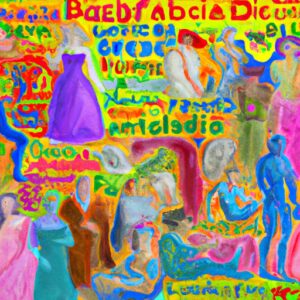What does “carino” mean?
“Carino” as a Vibe
Carino is an adjective, and as with all adjectives, it adapts to the gender and the number of the noun it refers to.
For instance “il tuo cappello è molto carino!” (your hat is very cute!) is masculine singular, while “la tua maglietta è molto carina” (your shirt is very nice) is feminine singular.
In English, the expression “carino” can translate to “cute” or “nice”. However, its use in Italian is very context-dependent.
As a person who grew up in Italy, whenever I think of the word “carino”, I immediately picture tiny streets in old cities.
When walking past the cafés, the shops, or the restaurants in Italy I am sure you will hear it at least once!
Did you buy a new jumper? Carino! Did you eventually go to the cinema with that guy you’re dating? Carino! Did he just help an old lady cross the street? Carino!
The exploration of this term isn’t just about language learning. It’s about cultural immersion and about stepping closer to understanding the Italian heart beyond words.
Cultural Significance and Emotional Connotations
What you might have understood already is that the emotional impact of “carino” varies with context.
In fact, “carino” has a very versatile use in Italian: it can describe beauty and physical attractiveness, but it is also frequently used to describe kindness or pleasantness in actions, as in “un gesto carino” (a kind gesture).
Using “carino” to describe someone’s actions is in fact very common in Italian. It reflects the value placed on kindness, something deeply ingrained in the Italian way of life, where courteous behavior is often the norm.
For instance, if I say “quel ragazzo è stato molto carino” (that guy has been very kind) I do not mean that he has been attractive in the past, but that he behaved in a nice way.
Or if I call a child’s drawing “carino, I aim at making the interaction feel sweeter and more genuine.
At the same time, if I compliment someone with the adjective “carino”, I am conveying at least some attractiveness towards that person.
The flexibility of its use enriches its everyday application, but it hasn’t always been like this.
Originally, “carino” was associated with prettiness only, but then its meaning has grown to encompass acts of kindness as well, showing the deep cultural layers of politeness and consideration in Italy.
Today, its use extends beyond mere aesthetics, reflecting changes in societal attitudes. If I think about the contexts in which I use it, in most of the cases I want to refer to someone’s manners rather than their look!
Practical Use of “Carino” in Italian
Now you learned that “carino” can be used in various conversational contexts. This means that the chances of using it in the wrong way are higher.
Let me provide you with some scenarios where “carino” can or should not be used.
| Context | Incorrect Usage | Why it’s Incorrect | Correction |
| Job Interview | “Che ufficio carino!” (What a cute office!) | Too informal for a formal setting like a job interview. | “Che ufficio elegante!” (What an elegant office!) |
| Funeral | “Che composizione carina!” (What a cute arrangement!) | Inappropriate and insensitive in a somber setting. | “Che composizione toccante!” (What a touching arrangement!) |
| Serious Book/Film | “È un film molto carino!” (It’s a very cute film!) | Undermines the seriousness of the topic.> | “È un film molto toccante!” (It’s a very touching film!) |
| Complimenting Achievement | “Che carino, hai ottenuto una promozione!” (How cute, you got a promotion!) | Belittles the significance of the achievement. | “Complimenti per la tua promozione!” (Congratulations on your promotion!)> |
Expressions with “Carino”
Exploring idiomatic expressions that contain “carino” can offer unique insights into how this adjective influences and reflects Italian cultural values and beliefs.
While “carino” itself might not be central in traditional proverbs, it appears in several colloquial expressions and modern idioms that highlight aspects of Italian social interactions and values.
Here I will list my favorite ones:
Essere carino con qualcuno.
To be nice to someone.
This is commonly used to describe a considerate or thoughtful behavior. It exemplifies the Italian value of cordiality, emphasizing the importance of treating others with kindness and respect.
Che carino!
How cute!
Often used when seeing something delightful or sweet, it reflects an Italian aesthetic that values beauty and charm in everyday life.
É stato molto carino.
It was very nice.
This is used when a behavior is considered polite. It emphasizes the importance of acting appropriately in social situations according to accepted cultural standards.
These expressions tie back to important aspects of Italian culture, like personal interactions, the emphasis on aesthetics and presentation, and the value of kindness and warmth in daily life.
Using “carino” in these contexts shows the linguistic flexibility of the term and how deeply it is ingrained in expressing positive social and aesthetic judgments.
These uses not only enrich communication but also strengthen social bonds, which are key components of Italian cultural life.
When I was younger, every time I went to a friend’s house my mum used to say “mi raccomando, sii carina!” (make sure you behave!).
There are many other ways we can say “behave” in Italian, but using “carino” conveys a specific and untranslatable meaning, which includes not only being polite, but also kind and considerate.
Is “Carino” Perceived Uniformly in Italy?
Regional Differences
In Italy, regional differences and dialects often influence the use and perception of certain words, and “carino” is no exception.
For instance, in Northern Italy, where people usually speak in a more straightforward way, “carino” might not be used as often, and it might be left for when speakers really mean to highlight something subtle and elegant.
On the other hand, in Southern Italy, where people are known for being more expressive, “carino” pops up a lot more in conversations. Speakers use it warmly and enthusiastically, especially when they’re talking about personal interactions or kind gestures.
In metropolitan areas like Milan or Rome, “carino” might also carry a slightly sophisticated or fashionable connotation, often used to describe trendy outfits or stylish decor.
Meanwhile, in rural or smaller towns, its usage might extend more to personal qualities and acts of kindness, reflecting a more community-centered and relational context.
Generational Differences
Among different generations, the usage of “carino” can vary significantly.
Older generations in Italy might use “carino” with a conservative undertone, primarily to describe things that are attractive or charming.
For my grandfather’s generation, for instance, “carino” might also carry a deeper sense of affection when referring to gestures or behaviors, aligning with traditional values of respect and courtesy.
Younger people, influenced by social media and global communication, might use “carino” in a broader range of contexts, such as describing things that are cool or appealing in a modern sense.
What I noticed among my friends and from my personal use of the term, is that “carino” is very much set against “bello” when used for aesthetic-related purposes.
If you show me a new backpack and I don’t really love it, I might say “carino!” and you would understand that, maybe, I am trying to be nice and not tell you that I dislike it.
The Beauty in the Simplicity
Now that you have embraced the historical, cultural, and emotional layers of “carino”, you have gained insights not just into a word, but into the fabric of Italian life itself.
One of my students once told me: “understanding carino reminded me that small words can carry big meanings, especially when they come from the heart.”
I believe this claim is central to grasping the meaning and the use of this magic Italian term.
Every time you use “carino” appropriately, you’re stepping closer to understanding the Italian heart and soul.
This will allow you to appreciate the beauty in simplicity, a principle that resonates through the cobblestone streets of Italy and the language that captures its essence.
Make sure you practice the use of this word in conversations, either with your Italian friends or with an AI tutor which adapts its pace to your needs.
Study Italian and remember: sii carino/a!









